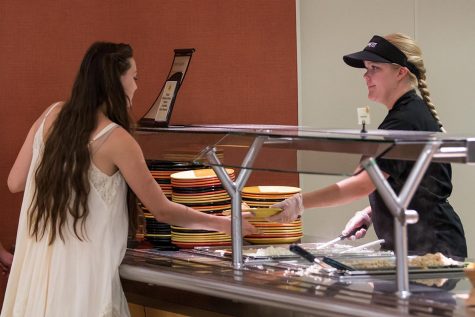How to practice thankfulness
The act of being thankful can be difficult and requires an understanding of value.
November 25, 2014
I am not good at being thankful. Every time I try to conjure up feelings of thankfulness or gratitude, I find other things — guilt, apathy or confusion — instead. My efforts become a futile cycle of trying to make myself feel more thankful. I work to focus on how grateful I should be for the wonderful food in front of me and the loving family around me, but I realize I think those things but do not actually feel them strongly. I try to muster up thankfulness, which does not work, and so I end up shoving too much turkey into my mouth in defeat.
So this year, I decided to try a new tactic. Instead of hoping to find myself thankful at the end of November, I began investigating what thankfulness is for and how one goes about becoming thankful. I decided on three things. Becoming thankful happens gradually, it requires an understanding of a thing’s value and an understanding of how I acquire that thing.
STARTING SMALL
I realized attempting to be thankful for really big things proved difficult — Jesus’s death on the cross, that I have a loving family, that we have a home — because, in a sense, I did not know what I was talking about. I do not know how to assign a value to Jesus’s death, I have always had the family I have and have never been homeless. I have no conception of life without those things and only an abstract understanding of how they benefit me.
So I started smaller with concrete things that I liked for simple reasons. My love for pumpkin pie filling came to mind. I can be grateful for pumpkin pie filling because I know its value — I like that taste, it makes me happy. It matters to me because I prefer and enjoy it.
In a simplistic sense, I can point to the effects of pie filling in my life and know when that effect does not exist. I become thankful for it because of what it does. This seems like a fundamental starting place for becoming thankful, but still too small for the crucifixion and the larger blessings in my life.
A TWO STEP PROCESS
The next step seems like the hardest. I have to realize my own value and that I do not deserve any of the things I receive. I am not intrinsically owed what I find myself possessing — home, family, health. Sure, in an immediate sense I take steps to acquire and maintain what I have, but much of it does not depend on me. I have some control over my health, but not completely. My health then remains undeserved or unmerited. It is a gift.
These two main movements toward thankfulness are related. We must rightly recognize the good of a thing, what it does and why that thing is valuable. Then we have to justify how it came into our possession. Often, it was given to us. Then, our thankfulness can be pointed towards the giver of that gift.
But this process often proves difficult. So start small. Practice finding things which have value you can identify. Try finding one thing for all of your senses — what do you like to touch, to taste? Then mark that they bring you joy. In this small sense at least, I can practice being truly and honestly thankful.






